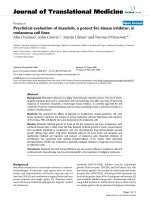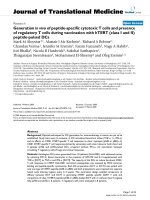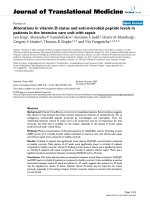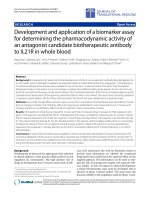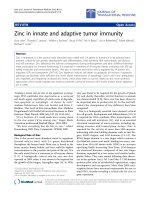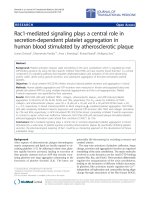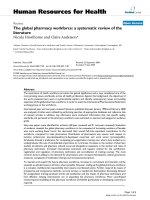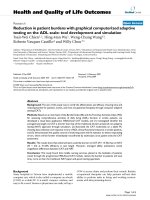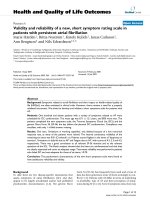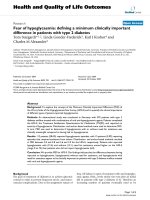báo cáo hóa học: " Bicarbonate in diabetic ketoacidosis - a systematic review" pptx
Bạn đang xem bản rút gọn của tài liệu. Xem và tải ngay bản đầy đủ của tài liệu tại đây (254.57 KB, 12 trang )
REVIEW Open Access
Bicarbonate in diabetic ketoacidosis - a
systematic review
Horng Ruey Chua
1
, Antoine Schneider
1
and Rinaldo Bellomo
1,2*
Abstract
Objective: This study was designed to examine the efficacy and risk of bicarbonate administration in the
emergent treatment of severe acidemia in diabetic ketoacidosis (DKA).
Methods: PUBMED database was used to identify potentially relevant articles in the pediatric and adult DKA
populations. DKA intervention studies on bicarbonate administration versus no bicarbonate in the emergent
therapy, acid-base studies, studies on risk association with cerebral edema, and related case reports, were selected
for review. Two reviewers independently conducted data extraction and assessed the citation relevance for
inclusion.
Results: From 508 potentially relevant articles, 44 were included in the systematic review, including three adult
randomized controlled trials (RCT) on bicarbonate administration versus no bicarbonate in DKA. We observed a
marked heterogeneity in pH threshold, concentration, amount, and timing for bicarbonate administration in various
studies. Two RCTs demonstrated transient improvement in metabolic acidosis with bicarbonate treatmen t within
the initial 2 hours. There was no evidence of improved glycemic control or clinical efficacy. There was retrospective
evidence of increased risk for cerebral edema and prolonged hospitalization in children who received bicarbonate,
and weak evidence of transient paradoxical worsening of ketosis, and increased need for potassium
supplementation. No studies involved patients with an initial pH < 6.85.
Conclusions: The evidence to date does not justify the administration of bicarbonate for the emergent treatment
of DKA, especially in the pediatric population, in view of possible clinical harm and lack of sustained benefits.
Introduction
Diabetic ketoacidosis (DKA) is a serious medical emer-
gency resulting from relative or absolute insulin defi-
ciency and the unopposed action of counter-regulatory
hormones, such as glucagon, cortisol, and catechola-
mines [1]. The hepatic met abolism of free fatty acids
generates ketoanions, such as beta-hydroxybutyrate and
acetoacetate [2,3]. Impaired tissue perfusion due to
volume contraction and the a drenergic response to the
often severe underlying precipitating illness result in lac-
tate production [4]. Acut e kidney injury leads to accu-
mulation of other unmeasured anions, such as sulphate,
urate, and phosphate [5]. All these, together with hyper-
chloremia which pre dominates during the recovery
phase of DKA [6], contribute to the development of
acidemia, which often is severe [7,8].
Experimental studies suggest that metabolic acidemia
can i mpair myocardial contractility, r educe cardiac out-
put, affect oxyhemoglobin dissociation and tissue oxygen
delivery, inhibit intracellular enzymes, such as phospho-
fructokinase, alter cellular metabolism, and result in
vital organ dysfunction [9-12]. Thus, the target of ther-
apy in DKA has historically placed importance on the
rapid reversal o f acidemia, in addition to the correction
of dehydration and insulin deficiency.
As a result of the physiological paradigm, correction
of severe acute acidemia with intravenous bicarbonate
to attenuate the deleterious effects continues to be uti-
lized by some practitioners. This approach has received
wide acceptance in the past, but based on currently
available evidence, and concerns about the potential
adverse effects in children and adults, the administration
of bicarbonate in DKA requires re-examination.
The objective of this systemic review was to examine
the medical evidence to date, on the administration of
* Correspondence:
1
Department of Intensive Care, Austin Health, Melbourne, Victoria, Australia
Full list of author information is available at the end of the article
Chua et al. Annals of Intensive Care 2011, 1:23
/>© 2011 Chua et al; licensee Springer. This is an Open Access article distributed under the terms of the Creative Commons Attribution
License ( , which permits unrestricted use, distribution, and reproduction in any medium,
provided the or iginal work is properly cited .
bicarbonate versus no bicarbonate, in the emergent
treatment of severe acidemia in pediatric and adult
patients with DKA, with regards to the physiological
and clinical efficacies and harms of this intervention.
Methods
Information source
Literature search was performed using the PUBMED
database. The list of potentially relevant article titles and
abstracts was generated by using the keywords, “bicarbo-
nate” AND “diabetic ketoacidosis.”
Study selection and eligibility criteria
Two investigators (HC and AS) independently reviewed
the article titles and abstracts. The following exclusion
criteria were first applied: 1) review articles; 2) commen-
taries, letters, or editorials; 3) non-English articles; 4)
animal studies; 5) all articles not related to acid-base
issues, bicarbonate use, or cerebral edema in DKA; 6)
publications before 1960.
The remaining papers were deemed relevant if they
fulfilled the following inclusion criteria:
1. Population: Both adult and pediatric populations
with diagnosis of DKA
2. Intervention: Intravenous sodium bicarbonate
therapy
3. Comparator: Bicarbonate administration versus no
bicarbonat e for the emergent tre atment of diabetic
ketoacidosis
4.Outcome:Primaryoutcomesarethedifferencein
mortality and duration of hospitalization. Secondary out-
come is a combination of various physiological and clin-
ical outcomes. Physiological outcomes include
reso lution of acidosis and ketosis, insulin sensitivity and
glycemic control, potassium balance, tissue oxygenation,
and cerebrospinal fluid (CSF) acidosis. Clinical outcomes
include hemodynamic stability and neurological out-
comes, including that of cerebral edema (CE)
5. Study type: All trials, including randomized and
nonrandomized case-control studies, as well as case
reports and series were selected.
Two investigators (HC and AS) reviewed all remaining
papers in entirety after the application of the above-
mentioned criteria. A third independent investigator
(RB) adjudicated any disagreements regarding paper
inclusion.
Results
Search results
The systematic search identified 508 potentially relevant
citations. Following application of the inclusion and
exclusion criteria, 44 articles were eventually selected
and the full manuscripts were reviewed. The selection
process is illustrated in Figure 1.
Study characteristics
Twelve publications were case-controlled studies on
bicarbonate administration versus no bicarbonate in
DKA. Of these, two studies were nonblinded rando-
mized controlled trials (RCT) [13,14], and one study
was a double-b lind RCT [15]. A total of 73 adult
patients were included in these three RCTs. The
remaining nine studies were nonrandomized, prospec-
tive, or retrospective studies, which include six adult
studies [16-21], two involving both adult and pediatric
patients [22,23], and one pediatric study [24]. No RCTs
have been performed in the pediatric cohort, and no
trials have examined bicarbonate treatment in DKA
patients with an admission pH < 6.85. In addition, four
pediatric nonrandomized prospective and retrospective
studies investigated the association between bicarbonate
administration in DKA and risk of CE [25-28]. There
were no similar studies in the adult DKA cohort.
Study threshold for and dose of bicarbonate
In Table 1 we summarized the threshold for bicarbonate
administration in various studies, which includes the
initial degree of acidemia and base deficit
[4,13-24,29-36]. There is heterogeneity of initial pH
threshold for bicarbonate therapy, which has become
more stringent over the years, from pH < 7.20 in the
past to pH < 7.00.
Dosing methods vary widely with study design and
physician preference, andthesearesummarizedin
Table 2. Concentrated bicarbonate dosing based on cal-
culations using predictive formulas incorporating base
deficit [37,38] results in a tendency for over- correc tion
and alkalosis [29,30]. Aiming for a more modest and
intermediate pH target with bicarbonate dose less than
half of that predicted, or dose titrated based on pH
severity, were some of the variable approaches adopted
subsequently by investigators [4,23]. Consequentially,
the average bica rbonate dose reported in studies appears
to have decreased over the years to an overall a mount
of 120-150 mmol for adults and 2 mmol/kg for children.
Slow infusions using half-isotonic or isotonic prepara-
tions (approximately 1%) or small intermittent boluses
of more concentrated preparation s (approximately 8.4%)
were preferenti ally used in later studies [13-15 ,17,1 8,20]
toavoidtoorapidpHorosmolalitychanges,withno
evidence of risk or benefit with either methods.
Primary outcomes
Duration of hospitalization
One single-center retrospective pediatric study assessed
duration of hospitalization as an outc ome measure [24].
Duration of hospitalization was significantly longer (87
vs. 67 hours, p = 0.01) for the bicarbonate group vs.
children treated without bicarbonate. However, there
Chua et al. Annals of Intensive Care 2011, 1:23
/>Page 2 of 12
was no adjustment for confounding variables. With mul-
tivariate analysis, duration o f hospitalization was 23%
longer in the bicarbonate group but did not reach statis-
tical significance (p = 0.07). Using 29 pairs of matched
patients (for calendar year, pH, and creatinine), duration
of hospitalization was 37% longer in the bicarbonate
group (p = 0.011).
In another brief report of 41 patients admitted for
severe DKA, 5 patients h ad pH < 7.0 (mean 6.85 ±
0.09); only 4 received a small 50- mmol bolus of sodi um
508 articles retrieved from PUBMED, using
the search terms:
“Bicarbonate” AND “Diabetic ketoacidosis”
464 articles as listed below were excluded:
- 94 review articles
- 29 commentaries/letters/editorials
- 80 non-English articles
- 15 animal studies
- 159 DKA articles not related to acid-
base issues, bicarbonate use, or
cerebral edema
- 87 articles not related to DKA
44 articles reviewed in entirety, including:
- 14 case reports/series on use of
bicarbonate in DKA
- 8 acid-base studies in DKA
- 12 case-control studies on use of
bicarbonate in DKA, including 3 RCT
- 6 case reports of cerebral edema in
DKA
- 4 studies on risk of cerebral edema in
DKA
Figure 1 Overview of study selection process.
Chua et al. Annals of Intensive Care 2011, 1:23
/>Page 3 of 12
bicarbonate, whereas 36 patients with pH > 7.0 (mean
7.15 ± 0.11) did not [21]. Bicarbonate therapy did not
seem to have an impact on duration of hospitalization.
Therefore, there m ay be a weak association with pro-
longed hospitalization in children with DKA treated
with additional bicarbonat e therapy, but the evidence is
of very poor quality.
Mortality outcome
No published trials on the use of bicarbonate therapy in
DKA were able to comment on any mort ality difference
with or without its use. Critically ill DKA cases with
severe metabolic acidemia were excluded from most
studies.
Secondary outcomes (physiological)
Resolution of acidosis
Eight case-control studies have examined the rates of
acidosis reversal with or without additional bicarbonate
therapy, including three RCTs. The results are summar-
ized in Table 3. Improvements in pH and serum bicar-
bonate levels were used as markers of acidosis reversal
[13-15,17-20,24].
Two adult RCTs demonstrated biochemical benefit in
terms of acidosis reversal time, with improved pH and
bicarbonate levels at 2 hours of therapy in the bicarbo-
nate arm. Of these, one study administered isotonic
bicarbonate as a slow infusion [13], whereas the other
administered small intermittent bicarbonate boluse s of
higher concentration titrated to sev erity of pH [15]. The
latter study extended the follow-up duration to 24 hours
of therapy and did not find a sustained biochemical ben-
efit beyond 2 hours. A third adult RCT administered
similar incremental small boluses of sodium bicarbonate
but did not establish a similar biochemical advantage
[14]. In addition, three retrospective adult studies
[17,18,20] and one retrospective pediatric study [24]
showed no improv ement in acidosis resolutio n with use
of bicarbonate therapy.
Resolution of ketosis
As shown in Table 3 two adult studies showed paradox-
ical worsening of ketonemia, including a slower decline
in ketonemia in the first hour of bicarbonate infusion in
a RCT [13], and an increase in plasma acetoacetate
levels during the initial three hours of bicarbo nate infu-
sion in a small, prospective, nonrandomized study [19].
Insulin sensitivity and glycemic control
Results of pediatric and adult studies that reported insu-
lin sensitivity and glycemic control as outcome measures
Table 1 Degree of baseline acidemia and base deficit in DKA patients with bicarbonate administered
Reference Population Nature of study Mean initial blood indices
pH Base deficit Bicarb (mmol/L)
Addis 1964 [29] A. (N = 3) Case series 6.94 Mostly unavailable
Kuzemko 1969 [30] P. (N = 6) Case series 7.05 23 8.0
Zimmet 1970 [4] A. (N = 11) Case series 7.09 24 4.4
Soler 1972 [22] A+P. (N = 18) Prospective C-C < 7.2 NR < 10.0
Krumlik 1973 [31] P. (N = 27) Case series 7.05 NR 7.6
Soler 1974 [32] A. (N = 1) Case report 6.85 NR 6.0
Munk 1974 [16] P. (N = 5) Prospective C-C 7.05 22 8.7
Assal 1974 [23] A+P. (N = 9) Retrospective C-C 7.06 NR 5.6
Keller 1975 [33] A. (N = 58)* Case series < 7.2 NR NR
Reddy 1977 [34] P. (N = 19) Case series 7.07 NR 6.5
Lutterman 1979 [17] A. (N = 12) Retrospective C-C 6.89 NR NR
Lever 1983 [18] A. (N = 52) Retrospective C-C 6.94-7.00
†
NR 3.4-4.3
†
Hale 1984 [13] A. (N = 16) RCT 6.85 NR 7.0
Morris 1986 [14]
‡
A. (N = 10) RCT 7.03 NR 3.6
Gamba 1991 [15]
‡
A. (N = 9) RCT (DB) 7.05 NR 2.9
Okuda 1996 [19] A. (N = 3) Prospective C-C 6.98 NR 2.0
Green 1998 [24] P. (N = 57) Retrospective C-C 7.02 40 NR
Viallon 1999 [20] A. (N = 24) Retrospective C-C 6.93 NR 3.1
Latif 2002 [21] A. (N = 4) Retrospective C-C 6.85 NR NR
Kamarzaman 2009 [35] A. (N = 1) Case report 6.27 41 4.0
Guneysel 2009 [36] A. (N = 1) Case report 6.82 27 8.4
A = adults; P = pediatrics; N = number of patients who received bicarbonate, if breakdown available; C-C = case-control; RCT = randomized, controlled trial;
DB = double-blinded; Bicarb = bicarbonate level; NR = not reported.
*Breakdown of patients with or without bicarbonate administered not provided.
†
Mean values provided separately for two different study centers.
‡
Patients with initial pH < 6.9 were excluded from the RCT.
Chua et al. Annals of Intensive Care 2011, 1:23
/>Page 4 of 12
are summarized in Table 4. No significant difference in
rate of glucose decline or insulin requirement was
demonstrated with bicarbonate treatment.
Potassium balance
Seven studies examined potassium balance as an out-
come measure and are summarized in Table 5. One
double-blind adult RCT, with mean bicarbonate dose of
84 ± 34 mmol, demonstrated lower serum potassium at
24 hours of therapy in the bicarbonate arm [15].
Another adult retrospective study, with mean bicarbo-
nate dose of 120 ± 40 mmol, showed higher potassium
supplementation in bicarbonate arm over 24 hours [20].
Four other studies (including one pediatric study) did
not detect any statistical difference in the potassium bal-
ance [14,17,18,24].
A mixed adult and pediatric, three-arm prospective
study, examined the association between mean cumula-
tive bicarbonate d oses and potassium requirement. The
two groups that received saline and low-dose bicarbo-
nate (mean 200 mmol) had comparable potassium sup-
plementation during first 24 hours, whereas the third
group with high bicarbonate dose (mean 400 mmol)
received higher potassium supplementation [22].
Tissue oxygenation
One adult RCT reported a significantly slower rate of
decline i n blood lactate and lactate to pyruvate ratio in
the bicarbonate treatment arm, compared with saline
control, in the first hour of treatment in DKA [13]. A
slow decline in blood lactate to pyruvate ratio was used
to imply tissue hypoxia. A subsequent pediatric nonran-
domized prospective study demonstrated that the initial
decline of in vivo P
50
(partial pressure of oxygen
required to saturate 50% of the hemoglobin oxygen
binding sites in a sample of whole blood) with DKA
treat ment was similar in both bicarbonate-treated group
and controls. Bicarbonate therapy was not shown to
affect oxygen transport adversely [16].
Cerebrospinal fluid acidosis
One adult RCT performed CSF a nalysis in approxi-
mately half of the adult patient cohort to investigate the
concern of paradoxical CSF acidosis with bicarbonate
administration. The study did not find any statistically
significant difference in CSF pH and bicarbonate levels
within 24 hours in the bicarbonate-treatment group and
control. However, patient numbers were small, and a
trend for larger decline in CSF pH at 6 to 8 hours was
Table 2 Summary of bicarbonate dose administered in case series and studies
Reference Nature of Study Dose of bicarbonate given (mean) Dose Estimation Timing (range)
Conc (%) Total (mM) Wt-adj (mM/kg)
Addis 1964 [29] CS 8.4 413 NR based on calculated dose 150 initial, and rest
over 1.5 to 12 hr
Kuzemko 1969 [30]
P
CS 8.4 255 NR based on calculated dose over 3 to 32 hr
Zimmet 1970 [4] CS NR 185 NR based on pH severity within initial 4 hr
(≈ half of calculated dose)
Soler 1972 [22]
AP
PrC 1.0 200 - 400
†
NR NR NR
Krumlik 1973 [31]
P
CS 7.5 115 (3.3/kg) to reach pH ≥ 7.2 based on calculated dose half over 30 min,
144 (3.9/kg) to reach pH ≥ 7.3 rest over 2 hrs
Munk 1974 [16]
P
PrC NR 130 2.44 NR NR
Assal 1974 [23]
AP
ReC NR 230 NR half of calculated dose given within initial 4 hr
Keller 1975 [33] CS NR 345 NR based on calculated dose within initial 24 hr
Reddy 1977 [34]
P
CS ≈ 0.6 NR 2.50 slow infusion till pH > 7.2 over mean of 4.9 hr
Lutterman 1979 [17] ReC 1.4 167 NR standard dose for all within initial 6 hr
Lever 1983 [18] ReC NR 130-135
╫
NR NR majority slow infusion
Hale 1984 [13] RCT 1.3 150 NR standard dose for all over 1 hr
Morris 1986 [14] RCT NR 120 NR titrated to pH, repeated till intermittent dose, over
pH > 7.15 30 min; 2 hr interval
Gamba 1991 [15] RCT (DB) ≈ 7.5 84 NR titrated to pH, repeated till intermittent dose, over
pH rise > 0.05 30 min; 2 hr interval
Okuda 1996 [19] PrC NR 200 NR standard dose (50 mmol/hr) over 4 hr
Green 1998 [24]
P
ReC NR NR 2.08 NR NR
Viallon 1999 [20] ReC 1.4 120 NR as per attending physician over 1 hr
Latif 2002 [21] ReC NR 50 NR standard dose for all NR
CS = case series; PrC = prospective case-control; ReC = retrospective case-control; RCT = randomized controlled trial; DB = double-blind; Conc = concentration;
NR = not reported; mM = mmol; Wt-adj = weight-adjusted
†
Mean values provided separately for two study arms;
╫
mean values provided separately for two study centers
P
Pediatric studies;
AP
mainly adults but including pediatric patients
Chua et al. Annals of Intensive Care 2011, 1:23
/>Page 5 of 12
Table 3 Key studies on resolution of acidosis and ketosis with bicarbonate therapy in DKA
References Trial design No. of patients
(bicarb vs. control)
Mean age (yr)
and initial pH
Bicarbonate infusion Control Acidosis and ketosis
Hale et al. [13] RCT 16 vs. 16 47 vs. 41 (1
st
hr: 1 L isotonic saline for all) Higher pH and bicarb levels at 2
hr
Br Med J 1984 (single center) 6.85 vs. 6.85 2
nd
hr: 1 L isotonic
bicarb vs.
1L
isotonic
saline
in bicarb arm vs. control, p < 0.01
BUT
(3
rd
hr: 1 L isotonic saline for all) Slower decline in blood ketone in
1st hr in bicarb arm
Morris et al. [14] RCT 10 vs.11 34 vs. 28 133.8 mmol if pH 6.9-
6.99
no alkali No difference in rate of change of
pH, bicarb, ketones
Ann Intern Med
1986
(single center) OR 89.2 mmol if pH
7.0-7.09
OR time to reach pH 7.3
7.03 vs. 7.00 OR 44.6 mmol if pH
7.1-7.14
OR bicarb levels to reach 15
mmol/L
(over 30 min, 2 hourly
until pH ≥ 7.15)
Gamba et al.
[15]
RCT 9 vs. 11 29 vs. 28 133.5 mmol/150 ml
(pH 6.9-6.99)
0.9%
saline,
also
Higher pH at 2 hr in bicarb arm, p
< 0.02
Rev Inves Clin
1991
double-blind 89 mmol/100 ml (pH
7.0-7.09)
in similar
aliquots
AND higher bicarb in bicarb arm,
p < 0.01
(single center) 7.05 vs. 7.04 44.8 mmol/50 ml (pH
7.1-7.14)
(over 30 min,
repeated at 2 hr
Change in pH and bicarb larger in
bicarb arm at 2 hr,
if pH increase by <
0.05)
p < 0.01
Okuda et al.
[19]
Prospective 3 vs. 4 24 vs. 34 50 mmol/hr over 4 hr No alkali Paradoxical increase in plasma
acetoacetate in 1
st
3hr
J Clin Endocrinol
Metab 1996
nonrandomized in bicarb arm vs. control
nonblinded 6.98 vs. 7.27 (IV insulin 0.1 U/kg/hr + 0.9%
saline)
Increase in plasma 3-
hydroxybutyrate level after bicarb
(single center) (p < 0.05) ceased vs. steady decline
throughout in control
Lutterman et al.
[17]
Retrospective 12 vs. 12 41 vs. 34 167 mmol/L in 1 L Low-dose
insulin
No difference in mean pH rise in
1
st
2hr
Diabetologia
1979
(single center) over 1 hr (if pH ≤ 7.0) IV 8 U/hr OR mean time to reach pH ≥ 7.30
6.89 (with high dose
insulin
OR rate of decline of ketosis
mean 260 U in 1st 6
hrs)
Lever et al. [18] Retrospective 52 (73 cases) 22.5-37.4 vs. mean 130-135 mmol No alkali No difference in mean change in
bicarb level per hr
Am J Med 1983 (2 centers) vs 24.5-48.0 (majority slow
infusion)
OR mean change in pH per hr
21 (22 cases) 6.94-7.00 vs.
6.89-7.07
Viallon et al.
[20]
Retrospective 24 vs. 15 45 vs. 47 mean 120 mmol (88-
166)
No alkali No difference in variation of mean
pH, bicarb level, AG
Chua et al. Annals of Intensive Care 2011, 1:23
/>Page 6 of 12
observed in the bicarbonate group [14]. In another non-
randomized study, the study subjects who received addi-
tional bicarbonate therapy for DKA [23] were compared
with controls from an older study, which used the usual
treatment with insulin and saline [39]. Bot h therapies
induced a paradoxical drop in CSF pH after treatment
for DKA, which was accompanied by a significantly
higher CSF P
CO2
and lesser increment in CSF bicarbo-
nate level compared to blood, with no significant
difference.
Table 3 Key studies on resolution of acidosis and ketosis with bicarbonate therapy in DKA (Continued)
Crit Care Med
1999
(single center) 1.4% over 1 hr
infusion
anion gap in 1st 24 hr
6.93 vs. 7.00 OR mean time to reach pH > 7.30
OR urine ketone clearance
Green et al[24] Retrospective 57 (90 cases) 9.6 vs. 10.1 mean 2.08 mmol/kg
(0.53-
No alkali Unadjusted rate of bicarb rise
faster in bicarb arm at
Ann Emerg Med
1998
(single center) vs 7.37 mmol/kg) 24 hr, p = 0.033
(pediatric) 49 (57 cases) 7.02 vs. 7.06 No difference in bicarb rise at 12
and 24 hr, or time to reach
bicarb of 20 mmol/L (matched
pair and multivariate analysis)
cases: DKA episodes; IV: intravenous; hr: hour; min: minutes; bicarb: bicarbonate.
Table 4 Studies on insulin sensitivity and glycemic control
Reference Trial design and
size
Bicarb dose
(intervention)
Insulin dose Glycemic control
Hale et al. [13] RCT 150 mmol IM 20 U in 1st hr, No difference in glucose decline over 2 hr
Br Med J 1984 Adults (N = 32) (standard) 6 U in both 2nd and 3rd
hr
Morris et al. [14] RCT 120.4 mmol Insulin 0.3 U/kg (IV + IM), No difference in time for glucose to reach
250 mg/dL
Ann Intern M 1986 Adults (N = 21) (mean) then IM 7 U/hr No difference in total insulin required
(1 hypoglycemia in control group)
Gamba et al. [15] RCT 84 mmol IV insulin 5 U/hr No difference in glucose levels throughout 24 hrs
Rev Cl In 1991 Adults (N = 20) (mean) No difference in total insulin required to reduce
glucose
to < 250 mg/dL, or till urine ketones were < 2+
Lutterman et al.
[17]
Retrospective 167 mmol High-dose insulin (mean No difference in glucose decline in 1st 2 hrs
Diabetologia 1979 Adults (N = 24) (standard) 260 ± 60 U in 1st 6 hr) No difference in mean glucose in 1st 8 hours
vs. low dose 8 U/hr (4 hypoglycemia in bicarb arm)
Lever et al. [18] Retrospective 130-135 mmol IM or IV insulin No difference in glucose decline in 7 - 9 hrs
Am J Med 1983 Adult (N = 73) (standard) 5-6 U/hr (for all) (2 hypoglycemia in bicarb arm)
Viallon et al. [20] Retrospective 120 ± 40 mmol IV insulin for all No difference in normalization time of glycaemia
Crit Care Med1999 Adult (N = 39) (mean) (dose unspecified) OR in mean quantity of insulin infused
Green et al. [24] Retrospective 2.08 mmol/kg IV insulin for all No difference in insulin requirement in 24 hrs
Ann Em Med 1998 Pediatrics (N = 106) (mean) (dose unspecified)
Okuda et al. [19] Prospective 200 mmol IV 0.1 U/kg bolus insulin No difference in glucose decline over 7 - 8 hrs
J Clin En M 1996 Adults (N = 7) (standard) and then IV 0.1 U/kg/hr
IM = intramuscular; IV = intravenous; U = units; bicarb = bicarbonate; L = liter; hr = hour.
Chua et al. Annals of Intensive Care 2011, 1:23
/>Page 7 of 12
Secondary outcomes (clinical)
Neurological deterioration and cerebral edema
The possible association of bicarbonate therapy with the
development of CE in DKA was highlighted in three non-
randomized studies t hat investigated risk factors for CE
in pediatric DKA patients (Table 6). Glaser et al. per-
formed a multicenter, case-control study and identified
61 children with CE. Bicarbonate therapy was the only
treatment variable associated with a greater risk of CE,
after comparing with matched controls. The relative risk
was 4.2 (95% confidenc e interval 1.5-12.1). Comparable
proportions of children in t he CE group and matched
control had bicarbonate infused within 2 hours before
neurological deterioration; hence no bias was detected
[25]. Two other smaller studies found a trend for bicar-
bonate use and an association with CE, but the risk was
not significant after adjusting for covariates, including
baseline acidosis [26,27]. A fourth pediatric study demon-
strated that impaired conscious level i n DKA was asso-
ciated with younger age and lower initial pH, and CE
cases had lower pH compared with matched controls
with no CE, at every conscious level studied [28]. No stu-
dies have examined CE risks in adult DKA population, in
which CE has only been rarely reported [40-42].
Other neurological outcomes
Three adult studies have examined neurological recovery
as a secondary outcome. One RCT examined mental
status at 0, 2, 6, 12, and 24 hours after therapy, and
found no difference in both treatment arms [15]. Two
other retrospective studies also found no difference in
neurological status with bicarbona te therapy, in patients
with varying degrees of impaired mental status at base-
line [18,20]. There were no pediatric studies on neurolo-
gical recovery.
Hemodynamic outcome
Three studies, i ncluding one RCT involving adult DKA
patients with admission pH > 6.90, reported changes i n
clinical parameters, such as heart rate, respiratory rate,
Table 5 Studies on potassium balance and supplementation
Reference Trial design and
size
Bicarb dose
(intervention)
Insulin dose Potassium balance and supplementation
Morris et al. [14] RCT 120.4 mmol Insulin 0.3 U/kg (IV +
IM),
No difference in serum K decline
Ann Intern Med
1986
Adults (N = 21) (mean) then IM 7 U/hr
Gamba et al. [15] RCT 84 mmol IV insulin 5 U/hr Lower serum K at 24 hr for bicarb arm vs. control,
Rev Cl In 1991 Adults (N = 20) (mean) p < 0.05
BUT trend for more K given in control
Soler et al. [22] Prospective Grp 1: none Grp 1: 234 U/24 hr More K requirement over 24 hr for Grp 3
Lancet 1972 Mixed (N = 25) Grp 2: 200 mmol Grp 2: 287 U/24 hr Estimated 30 mmol/L of K needed for Grps 1 & 2,
(3-arm study; age 13-84 yr) Grp 3: 400 mmol Grp 3: 288 U/24 hr & 40 mmol/L for Grp 3
only 2 groups randomized (per L of fluid infused)
Lutterman et al.
[17]
Retrospective 167 mmol High-dose insulin
(mean
No difference in mean serum K
Diabetologia 1979 Adults (N = 24) (standard) 260 ± 60 U in 1st 6 hr) No difference in K requirement over 12 hrs
vs. low dose 8 U/hr
Lever et al. [18] Retrospective 130-135 mmol IM or IV insulin No difference in K requirement
Am J Med 1983 Adults (N = 73) (standard) 5-6 U/hr (for all) 6 hypokalemia (< 3.3 mmol/L) in bicarb arm, 1 in
control
Viallon et al. [20] Retrospective 120 ± 40 mmol IV insulin for all More K requirement over 24 hr for bicarb arm,
Crit Care Med1999 Adults (N = 39) (mean) (dose unspecified) p < 0.001
1 hypokalemia (< 3 mmol/L) in bicarb arm
Green et al. [24] Retrospective 2.08 mmol/kg IV insulin for all No difference in hypokalemia occurrence
Ann Emerg Med
1998
Pediatrics (N = 106) (mean) (dose unspecified)
Grp = group; IM = intramuscular; IV = intravenous; U = units; K = potassium; bicarb = bicarbonate; L = liter.
Chua et al. Annals of Intensive Care 2011, 1:23
/>Page 8 of 12
and mean arterial pressure as outcome measures. None
reported any difference in clinical parameters with or
without added use of bicarbonate [15,18,20].
Discussion
Summary of evidence
We conducted a systematic review of the literature,
comparing additional use of bicarbonate infusion versus
the usual treatment with insulin and hydration, in pedia-
tric and adult patients with DKA. We have found
marked heterogeneity and no clear evidence, with
regards to the threshold for, concentration, amount, and
timing of bicarbonate administration. In addition to
such variability of treatment, there was retrospective evi-
dence of clinical harm, such as increased risk for CE and
prolonged hospitalization in children, and weak evidence
of physiological harm, such as transient paradoxical
worsening of ketosis and increased need for potassium
supplementation. Theoretical benefits perceived with
rapid acidemia reversal were not evident, apart from
weak evidence of transie nt improvement in acidosis,
with no evidence of any clinical efficacy.
Physiological impact of bicarbonate therapy in DKA
The primary ca use of acidemia in patients with DKA is
ketoacidosis, with contribution from lactic acidosis and
renal dysfunction. After metabolism of ketones during
the recovery phase, bicarbonate is regenerated and aids
the resolution of acidosis but is potentially affected by
the development of hyperchloremia, which has been
reported in more than 50% of adult and pediatric
patients after 4 hours of therapy in DKA, and in more
than 90% of patients by 8 to 20 hours [7,43 ]. It was
observed and suggested in these studies that hyper-
chloremic acidosis is likely contributed by preferential
renal excretion of ketones over chloride anion and
volume repletion with saline, with the most rapid rise in
hyperchloremia coinciding with the period of greatest
Table 6 Studies on risk of cerebral edema in pediatric DKA population
References Trial design Case (children
with CE)
Control(s) Associated risks of CE Bicarb therapy and CE risk
Glaser et al.
[25]
Retrospective N = 61 N = 174 (matched) Higher urea nitrogen and lower
arterial P
CO2
levels
Bicarb therapy significantly a/w CE
(matched control)
NEJM 2001 case-control Mean age: 8.9 yr Mean age: 9.0 yr at presentation (matched and
random controls)
(23 of 61 with CE received bicarb;
(multicenter) Mean pH: 7.06 Mean pH: 7.09 and vs. 43 of 174 matched controls);
USA +
Australia
(matched for age, DM onset, pH/bicarb,
glucose)
smaller increase in Na+ (matched
control)
RR 4.2 (p = 0.008)
N = 181 (random) and
Mean age: 11.3 yr Younger age, newly dx DM, lower
pH, higher
Mean pH: 7.12 glucose & Cr at presentation
(random control)
Lawrence et
al. [26]
Prospective
+
N = 21 N = 42 (mostly
random)
Lower bicarb, higher urea, higher
glucose levels
Trend towards association for bicarb
therapy with CE
J Pediatrics
2005
Retrospective Mean age: 9.0 yr Mean age: 9.6 yr at presentation (data for bicarb therapy available in 17
CE cases,
case-control Mean pH: 7.10 Mean pH: 7.20 with 34 random controls)
(multicenter) (13 prospective,(matched for
institution
Canada 8 retrospective) and data collection
duration)
Edge et al.
[27]
Prospective N = 43 N = 169 Lower pH and/or lower bicarb
levels, higher urea
Unadjusted OR of bicarb Rx for CE risk
of 3.7 (p < 0.05)
Diabetologia
2006
case-control Mean age: 8.5 yr Mean age: 8.9 yr and potassium levels at
presentation;
After adjustments for matching
variables and baseline
(multicenter) Mean pH: 7.00 Mean pH: 7.20 more cumulative fluid volume
given in 1st 4 hr,
acidosis, OR reduced to 1.5 (not
significant)
United
Kingdom
(matched for age, sex, DM onset,
admission month)
insulin administration in 1st hr, and
higher quantity
of insulin given over 1st 2 hr
DM = diabetes mellitus; bicarb = bicarbonate; Na+ = sodium; Cr = creatinine; CE = cerebral edema; neuro = neurological; RR = relative risk; OR = odds ratio; Rx =
treatment.
Chua et al. Annals of Intensive Care 2011, 1:23
/>Page 9 of 12
saline administration [43]. Theoretically, adjunct use of
bicarbonate administration maybemorebeneficialin
the scenario of reduced renal b icarbonate genesis with
concomitant acute kidney injury or in hyperchloremic
acidosis where there is defici ency of bicarbonate relative
to chloride.
Although bicarbonate therapy in DKA has been shown
in two RCTs to improve acidosis resolution in the initial
few hours of therapy, the comparator consisted of
sodium chloride infusion. Thus, the initial favorable
physiologic outcome with bicarbonate therapy might
represent a reduced risk of hyperchloremic acidosis.
Despite so, patient numbers were small, and this transi-
ent physiological benefit had not been demonstrated to
persist beyond the initial 2 hours. Concerns were raised
that bicarbonate therapy might interfere with tissue oxi-
dation and with the cle arance or renal excretion of
ketones, hence accounting for the paradoxical worsening
of ketosis.
Severe acidosis may inhibit the action of insulin on
glucose utilization. Insulin resistance in humans has
been shown to be higher at lower pH range and resis-
tance to fall steeply at pH ab ove 7.2 [44]. Early and
rapid correction of acidemia can theoretically increase
insulin sensitivity. However, as discussed, there is no
evidence of the above-postulated benefit of bicarbonate
therapy. Instead, lower serum potassium and increased
need for potassium supplementation had been demon-
strated by mainly adult studies, including one small
RCT, in the bicarbonate treatment arm. Although no
fatal outcomes or arrhythmias had been reported as a
result of hypokalemia, it would be prudent to pay close
attention to this anticipated complication.
Acute reversal of acidemia with bicarbonate also has
been linked to worsening of tissue hypoxia. Acidosis
induces a mild increase in P
50
and reduced hemoglobin-
oxygen affinity (Bohr effect), but at the same time is
associated with lower levels of 2,3-diphosphoglycerate
(2,3-DPG) in erythrocytes [45], which leads to a coun-
teractive increased hemoglobin-oxygen affinity. In the
initial presentation of DKA, a fine balance exists in
favor of the former (Bohr effect) [16], which can theore-
tically be disrupted by rapid treatment of acidemia, as
2,3-DPG levels were demonstrated to remain strikingly
low for days despite improvement in acidosis [46],
resulting in net increase in hemoglobin-oxygen affinity
and impaired tissue oxygenation. However, this phe-
nomenon is generally seen in the initial treatment phase
of DKA, regardless of bicarbonate therapy. P
50
,along
with blood lactate to pyruvate ratio, are merely surro-
gate markers of peripheral tissue oxygenation used in
studies. Therefore, there remains to be insufficient evi-
dence that additional bicarbonate administration affects
tissue oxygenation adversely.
Bicarbonate therapy in patients with DKA appeared to
be associated with increased obtundation and profound
cerebrospinal fluid (CSF) acidosis in an early study [47].
Apossibleexplanationforthisobservationmaybethe
preferential movement across the blood-br ain barrier of
CO
2
compared with bicarbonate during treatment of
DKA, when both P
CO2
and bicarb onate levels rise in the
blood. It was postulated that rapid reversal of acidemia
with bicarbonate might promote paradoxical CSF acido-
sis and contribute to adverse neurological outcomes.
However, we have not found any evidence that bicarbo-
nate infusion causes increased paradoxical CSF acidosis
compared with conventional DKA treatment.
In essence, most of the theoretical biochemical gains
and harm with bicarbonate administration were not evi-
dent in actual case scenarios, and the overall physiologi-
cal impact with such treatment is dismal.
Clinical impact of bicarbonate therapy in DKA
CE followed by coma is a devastating complication of
DKA, with an incidence of 1% and mortality of 24%
[25,27], and appears to be essentially exclusive to chil-
dren and young adolescents [48]. The pathophysiology
of CE remains unclear, and a detailed discussion on this
is beyond the scope of this article. In essence, possible
mechanisms include initial cerebral vasoconstriction and
reduced cerebral blood flow from acidosis and hypocap-
nia, cytotoxic edema, and cerebral injury, followed by
cerebral hyperemia, reperfusion injury, and vasogenic
edema, coupled with increased blood brain barrier per-
meability, during the rehydration phase of DKA [48,49].
Several reports of sudden death following irreversible
coma in children and young adults with DKA were pub-
lished in the 1960s, including development of diabetes
insipidus in some, with postmo rtem findings of CE and
neuronal degeneration [50-52].
From our earlier discussion, it is apparent that cere-
bral function in DKA is related to severity of acidosis,
even when there is no occurrence of CE. There were no
details on the reasons for bicarbonate administration in
previously mentioned studies on CE in children with
DKA, and it would be logical to assume that those who
were given bicarbonate were likely to have more severe
DKA or even circulatory collapse, factors which by
themselves might predispose to adverse neurological
outcomes. It should be noted that studies on risk factors
for CE were based on historical cases, when the use of
bicarbonate frequently accompanied high-dose insulin
protocols, where the combination of both might have
theoretically worsened the risk of CE.
Apart from the risk of CE, we also have discussed the
retrospective evidence that bicarbonate therapy is asso-
ciated with prolonged hospita lization in the pediatric
DKA cohort. Such studies were again subjected to the
Chua et al. Annals of Intensive Care 2011, 1:23
/>Page 10 of 12
natural confounder that children admitted with a lower
arterial pH (who were potentially more ill) and in earlier
studyyearsweremorelikelytobegivensodiumbicar-
bonate. On the other hand, there is no evidence that the
rapid reversal of acidemia with bicarbonate therapy
improves any clinical outcome, especially in the pedia-
tric cohort. Documentatio n of impro ved mental status
from initial diabetic coma following treatment (including
bicarbonate therapy) came only from pediatric and adult
case reports and series [23,29,30,36]. It could not be
ascertained, however, if a favorable neurological out-
come was attributable to the use of initial bicarbonate
therapy.
In addition, there is no evidence of improved hemody-
namic stability with the use of bicarbonate administra-
tion in DKA. Much of the perceived benefit in acute
reversal of severe acidemia is only based on animal and
experimental studies, which demonstrated weakened
end-organ response to catecholamines at pH < 7.2, with
bradycardia, negative inotropism, impaired cardiac out-
put, peripheral vas odilatation, and refractory hypoten-
sion [53]. Therefore, even though the clinical harm with
bicarbonate treatment is merely an association (and not
causation), the lack of clinical benefits does not justify
its routine use especially in children.
Limitations of studies
In general, patient numbers in the three adult RCTs
were small and lacked the statistical power to examine
clinical outcomes. Most prospective trials excluded
patients with severe concomitant illnesses, in whom the
adverse cardiovascular effects of severe acidemia are
believed to be more significantly seen. There were no
trials performed in the scenario of more severe acidemia
(pH < 6.85), and it seems unlikely that such studies will
be performed. Understandably, documentation of p re-
sumed benefits of b icarbonate rescue in cases of DKA
presenting with more severe acidemia and cardiovascu-
lar collapse or significant hemodynamic compromise
were confined to case reports [32,35,36]. Clinical judg-
ment, opinion, and expertise prevail in such ci rcum-
stances in the absence of trials. There are a paucity of
data on bicarbonate administration in the pediatric DKA
population with no randomized trials performed, forcing
the extrapolation of adult data, despite the likelihood
that the pathophys iology in both cohorts are fundamen-
tally different. Studies that report clinical harm with
bicarbonate treatment in children are all retrospective in
design and subjected to the various confounders as dis-
cussed earlier.
There were limited DKA trials during the past decade,
especially in the context of modern day emergency med-
icine or intensive care. The data of the past decade were
mostly focused on the adverse neurological outcome of
bicarbonate treatment in the pediatric DKA population.
There is increasing recognition of the development of
hyperchloremic acidosis for the treatment phase of DKA
with fluid resu scitation, which might impact the resolu-
tion of acidemia [54]. The clinical effects of hyperchlore-
mic acidosis remain uncertain.
Conclusions
Theevidencetodatedoesnotsupporttheuseof
bicarbonate administration for the emergent treatment
of DKA, especially in the pediatric population, in vi ew
of possible clinical and physiological harm and the lack
of clinical or sustained physiological benefits. There
also is insufficient evidence to justify the recommenda-
tion of bicarbonate administration in more extreme
acidemia of pH < 6.90. Future research should focus
on the use of more balanced and physiological resusci-
tation fluids with buffering capacity, in the modern
context of DKA management, with the goal of redu-
cing the component of hyperchloremic acidosis in
DKA while minimizing the risk of CSF acidosis and
associated CE.
Acknowledgements
Dr Horng Ruey Chua was a recipient of the Singapore Health Manpower
Development Programme (HMDP) award in 2010, which was co-funded by
the Ministry of Health (MOH) Singapore, and National University Health
System (NUHS) Singapore. The funds were utilized for his clinical and
research training in Austin Health, Melbourne, Australia.
Author details
1
Department of Intensive Care, Austin Health, Melbourne, Victoria, Australia
2
Australia and New Zealand Intensive Care (ANZIC) - Research Centre,
Monash University, Melbourne, Victoria, Australia
Authors’ contributions
RB and HRC conceived the topic review idea and proposal. HRC and AS
performed the literature search and selected the relevant articles for
inclusion independently. RB adjudicated any disagreements in article
inclusion. HRC, AS, and RB reviewed the selected articles in entirety. HRC
and RB wrote the initial draft of the manuscript. All authors reviewed and
edited the manuscript.
Competing interests
The authors declare that they have no competing interests.
Received: 4 June 2011 Accepted: 6 July 2011 Published: 6 July 2011
References
1. Durward A: Diabetic ketoacidosis. In Critical Care Nephrology 2 edition.
Edited by: Ronco C, Bellomo R, Kellum J. Philadelphia: Saunders, Elsevier;
2009:641-647, Acid-base problems.
2. McGarry J, Wright PH, Foster DW: Hormonal control of ketogenesis. Rapid
activation of hepatic ketogenic capacity in fed rats by anti-insulin serum
and glucagon. J Clin Invest 1975, 55:1202-1209.
3. McGarry JD, Foster DW: Regulation of hepatic fatty acid oxidation and
ketone body production. Annu Rev Biochem 1980, 49:395-420.
4. Zimmet PZ, Taft P, Ennis GC, Sheath J: Acid production in diabetic
acidosis; a more rational approach to alkali replacement. British Medical
Journal 1970, 3:610-612.
5. Calzavacca P, Lacari E, Bellomo R: Renal failure. In Stewart’s Textbook of
Acid-Base Edited by: Ebers P, Kellum J Lulu.com 2009, 394-395, Clinical
applications of quantitative acid-base medicine.
Chua et al. Annals of Intensive Care 2011, 1:23
/>Page 11 of 12
6. Oh MS, Carroll HJ, Goldstein DA, Fein IA: Hyperchloremic acidosis during
the recovery phase of diabetic ketosis. Annals of Internal Medicine 1978,
89:925-927.
7. Adrogue HJ, Wilson H, Boyd AE, Suki WN, Eknoyan G: Plasma acid-base
patterns in diabetic ketoacidosis. N Engl J Med 1982, 307:1603-1610.
8. Foster DW, McGarry JD: The metabolic derangements and treatment of
diabetic ketoacidosis. N Engl J Med 1983, 309:159-169.
9. Mitchell JH, Wildenthal K, Johnson RL Jr: The effects of acid-base
disturbances on cardiovascular and pulmonary function. Kidney Int 1972,
1:375-389.
10. Kono N, Kuwajima M, Tarui S: Alteration of glycolytic intermediary
metabolism in erythrocytes during diabetic ketoacidosis and its recovery
phase. Diabetes 1981, 30:346-353.
11. Adrogue HJ, Madias NE: Management of life-threatening acid-base
disorders. First of two parts. N Engl J Med 1998, 338:26-34.
12. Kraut JA, Kurtz I: Use of base in the treatment of severe acidemic states.
American Journal of Kidney Diseases 2001, 38:703-727.
13. Hale PJ, Crase J, Nattrass M: Metabolic effects of bicarbonate in the
treatment of diabetic ketoacidosis. British Medical Journal Clinical Research
Ed 1984, 289:1035-1038.
14. Morris LR, Murphy MB, Kitabchi AE: Bicarbonate therapy in severe diabetic
ketoacidosis. Annals of Internal Medicine 1986, 105:836-840.
15. Gamba G, Oseguera J, Castrejon M, Gomez-Perez FJ: Bicarbonate therapy
in severe diabetic ketoacidosis. A double blind, randomized, placebo
controlled trial. Revista de Investigacion Clinica 1991, 43:234-238.
16. Munk P, Freedman MH, Levison H, Ehrlich RM: Effect of bicarbonate on
oxygen transport in juvenile diabetic ketoacidosis. Journal of Pediatrics
1974, 84:510-514.
17. Lutterman JA, Adriaansen AA, van ‘t Laar A: Treatment of severe diabetic
ketoacidosis. A comparative study of two methods. Diabetologia 1979,
17:17-21.
18. Lever E, Jaspan JB: Sodium bicarbonate therapy in severe diabetic
ketoacidosis. American Journal of Medicine 1983, 75:263-268.
19. Okuda Y, Adrogue HJ, Field JB, Nohara H, Yamashita K: Counterproductive
effects of sodium bicarbonate in diabetic ketoacidosis. Journal of Clinical
Endocrinology & Metabolism 1996,
81:314-320.
20. Viallon A, Zeni F, Lafond P, Venet C, Tardy B, Page Y, Bertrand JC: Does
bicarbonate therapy improve the management of severe diabetic
ketoacidosis? Critical Care Medicine 1999, 27:2690-2693.
21. Latif KA, Freire AX, Kitabchi AE, Umpierrez GE, Qureshi N: The use of alkali
therapy in severe diabetic ketoacidosis. Diabetes Care 2002, 25:2113-2114.
22. Soler NG, Bennett MA, Dixon K, FitzGerald MG, Malins JM: Potassium
balance during treatment of diabetic ketoacidosis with special reference
to the use of bicarbonate. Lancet 1972, 2:665-667.
23. Assal JP, Aoki TT, Manzano FM, Kozak GP: Metabolic effects of sodium
bicarbonate in management of diabetic ketoacidosis. Diabetes 1974,
23:405-411.
24. Green SM, Rothrock SG, Ho JD, Gallant RD, Borger R, Thomas TL,
Zimmerman GJ: Failure of adjunctive bicarbonate to improve outcome in
severe pediatric diabetic ketoacidosis. Annals of Emergency Medicine 1998,
31:41-48.
25. Glaser N, Barnett P, McCaslin I, Nelson D, Trainor J, Louie J, Kaufman F,
Quayle K, Roback M, Malley R, et al: Risk factors for cerebral edema in
children with diabetic ketoacidosis. The Pediatric Emergency Medicine
Collaborative Research Committee of the American Academy of
Pediatrics. New England Journal of Medicine 2001, 344:264-269.
26. Lawrence SE, Cummings EA, Gaboury I, Daneman D: Population-based
study of incidence and risk factors for cerebral edema in pediatric
diabetic ketoacidosis. Journal of Pediatrics 2005, 146:688-692.
27. Edge JA, Jakes RW, Roy Y, Hawkins M, Winter D, Ford-Adams ME,
Murphy NP, Bergomi A, Widmer B, Dunger DB: The UK case-control study
of cerebral oedema complicating diabetic ketoacidosis in children.
Diabetologia 2006, 49:2002-2009.
28. Edge JA, Roy Y, Bergomi A, Murphy NP, Ford-Adams ME, Ong KK,
Dunger DB: Conscious level in children with diabetic ketoacidosis is
related to severity of acidosis and not to blood glucose concentration.
Pediatric Diabetes 2006, 7:11-15.
29. Addis GJ, Thomson WS, Welch JD: BICARBONATE THERAPY IN DIABETIC
ACIDOSIS. Lancet 1964, 2:223-225.
30. Kuzemko JA, Fielding DW, Hudson FP: The management of acid-base
balance in children with diabetic acidosis. Postgrad Med J 1969, 45:21-26.
31. Krumlik JJ, Ehrlich RM: Insulin and sodium bicarbonate treatment of
diabetic acidosis: a retrospective review. Journal of Pediatrics 1973,
83:269-271.
32. Soler NG, Bennett MA, Fitzgerald MG, Malins JM: Successful resuscitation in
diabetic ketoacidosis: a strong case for the use of bicarbonate.
Postgraduate Medical Journal 1974, 50:465-468.
33. Keller U, Berger W, Ritz R, Truog P: Course and prognosis of 86 episodes
of diabetic coma. A five year experience with a uniform schedule of
treatment. Diabetologia 1975, 11:93-100.
34. Reddy CM, Orti E: Insulin and sodium bicarbonate treatment in diabetic
ketoacidosis in children. Journal of the National Medical Association 1977,
69:355-357.
35. Kamarzaman Z, Turner C, Clark F: How low can you go: a case
presentation on a patient with diabetic ketoacidosis. Resuscitation, Ireland
2009, 80:967-968.
36. Guneysel O, Guralp I, Onur O: Bicarbonate therapy in diabetic
ketoacidosis. Bratislavske Lekarske Listy 2008, 109:453-454.
37. Mellemgaard K, Astrup P: The Quantitative Determination of Surplus
Amounts of Acid or Base in the Human Body. Scandinavian Journal of
Clinical & Laboratory Investigation 1960, 12:187-199.
38. Astrup P, Jorgensen K, Andersen OS, Engel K: The acid-base metabolism. A
new approach. Lancet 1960, 1:1035-1039.
39. Ohman JL, Marliss EB, Aoki TT, Munichoodappa CS, Khanna VV, Kozak GP:
The cerebrospinal fluid in diabetic ketoacidosis. N Engl J Med 1971,
284:283-290.
40. Troy PJ, Clark RP, Kakarala SG, Burns J, Silverman IE, Shore E: Cerebral
edema during treatment of diabetic ketoacidosis in an adult with new
onset diabetes. Neurocrit Care, United States 2005, 2:55-58.
41. Hiller KM, Wolf SJ: Cerebral edema in an adult patient with diabetic
ketoacidosis. Am J Emerg Med, United States 2005, 23:399-400.
42. Haringhuizen A, Tjan DH, Grool A, van Vugt R, van Zante AR: Fatal cerebral
oedema in adult diabetic ketoacidosis. Netherlands Journal of Medicine
2010, 68:35-37.
43. Taylor D, Durward A, Tibby SM, Thorburn K, Holton F, Johnstone IC,
Murdoch IA: The influence of hyperchloraemia on acid base
interpretation in diabetic ketoacidosis. Intensive Care Med 2006,
32:295-301.
44. Walker BG, Phear DN, Martin FI, Baird CW: INHIBITION OF INSULIN BY
ACIDOSIS. Lancet 1963, 2:964-965.
45. Ibrahim Eel D, McLellan SA, Walsh TS: Red blood cell 2,3-
diphosphoglycerate concentration and in vivo P50 during early critical
illness. Crit Care Med, United States 2005, 33:2247-2252.
46. Alberti KG, Emerson PM, Darley JH, Hockaday TD: 2,3-Diphosphoglycerate
and tissue oxygenation in uncontrolled diabetes mellitus. Lancet 1972,
2:391-395.
47. Posner JB, Plum F: Spinal-fluid pH and neurologic symptoms in systemic
acidosis.
N Engl J Med 1967, 277:605-613.
48. Bohn D: Understanding the pathophysiology of cerebral edema in
diabetic ketoacidosis: another brick in the wall? Pediatr Crit Care Med,
United States 2010, 11:421-423.
49. Glaser N: Cerebral injury and cerebral edema in children with diabetic
ketoacidosis: could cerebral ischemia and reperfusion injury be
involved? Pediatr Diabetes, Denmark 2009, 10:534-541.
50. Fitzgerald MG, O’Sullivan DJ, Malins JM: Fatal Diabetic Ketosis. Br Med J
1961, 1:247-250.
51. Young E, Bradley RF: Cerebral edema with irreversible coma in severe
diabetic ketoacidosis. N Engl J Med 1967, 276:665-669.
52. Taubin H, Matz R: Cerebral edema, diabetes insipidus, and sudden death
during the treatment of diabetic ketoacidosis. Diabetes 1968, 17:108-109.
53. Riley LJ, Cooper M, Narins RG: Alkali therapy of diabetic ketoacidosis:
biochemical, physiologic, and clinical perspectives. Diabetes-Metabolism
Reviews 1989, 5:627-636.
54. Mahler SA, Conrad SA, Wang H, Arnold TC: Resuscitation with balanced
electrolyte solution prevents hyperchloremic metabolic acidosis in
patients with diabetic ketoacidosis. Am J Emerg Med Elsevier Inc; 2010.
doi:10.1186/2110-5820-1-23
Cite this article as: Chua et al .: Bicarbonate in diabetic ketoacidosis - a
systematic review. Annals of Intensive Care 2011 1:23.
Chua et al. Annals of Intensive Care 2011, 1:23
/>Page 12 of 12
